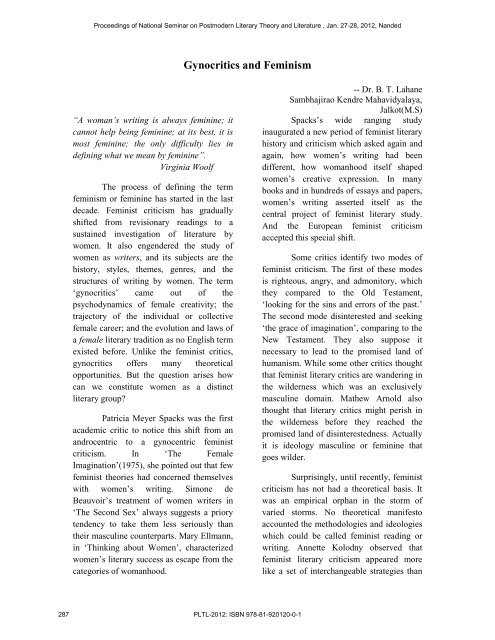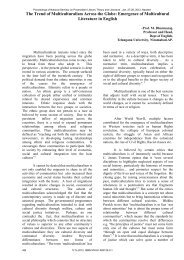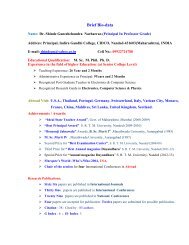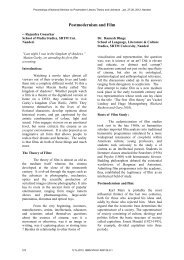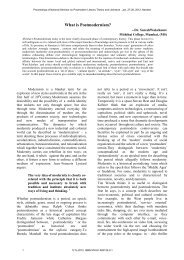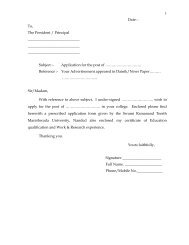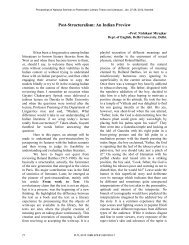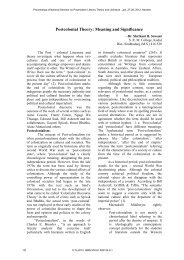Postcolonial Feminist Theory: An Overview - Igcollege.org
Postcolonial Feminist Theory: An Overview - Igcollege.org
Postcolonial Feminist Theory: An Overview - Igcollege.org
You also want an ePaper? Increase the reach of your titles
YUMPU automatically turns print PDFs into web optimized ePapers that Google loves.
Proceedings of National Seminar on Postmodern Literary <strong>Theory</strong> and Literature , Jan. 27-28, 2012, NandedGynocritics and Feminism“A woman’s writing is always feminine; itcannot help being feminine; at its best, it ismost feminine; the only difficulty lies indefining what we mean by feminine”.Virginia WoolfThe process of defining the termfeminism or feminine has started in the lastdecade. <strong>Feminist</strong> criticism has graduallyshifted from revisionary readings to asustained investigation of literature bywomen. It also engendered the study ofwomen as writers, and its subjects are thehistory, styles, themes, genres, and thestructures of writing by women. The term‘gynocritics’ came out of thepsychodynamics of female creativity; thetrajectory of the individual or collectivefemale career; and the evolution and laws ofa female literary tradition as no English termexisted before. Unlike the feminist critics,gynocritics offers many theoreticalopportunities. But the question arises howcan we constitute women as a distinctliterary group?Patricia Meyer Spacks was the firstacademic critic to notice this shift from anandrocentric to a gynocentric feministcriticism. In ‘The FemaleImagination’(1975), she pointed out that fewfeminist theories had concerned themselveswith women’s writing. Simone deBeauvoir’s treatment of women writers in‘The Second Sex’ always suggests a priorytendency to take them less seriously thantheir masculine counterparts. Mary Ellmann,in ‘Thinking about Women’, characterizedwomen’s literary success as escape from thecategories of womanhood.-- Dr. B. T. LahaneSambhajirao Kendre Mahavidyalaya,Jalkot(M.S)Spacks’s wide ranging studyinaugurated a new period of feminist literaryhistory and criticism which asked again andagain, how women’s writing had beendifferent, how womanhood itself shapedwomen’s creative expression. In manybooks and in hundreds of essays and papers,women’s writing asserted itself as thecentral project of feminist literary study.<strong>An</strong>d the European feminist criticismaccepted this special shift.Some critics identify two modes offeminist criticism. The first of these modesis righteous, angry, and admonitory, whichthey compared to the Old Testament,‘looking for the sins and errors of the past.’The second mode disinterested and seeking‘the grace of imagination’, comparing to theNew Testament. They also suppose itnecessary to lead to the promised land ofhumanism. While some other critics thoughtthat feminist literary critics are wandering inthe wilderness which was an exclusivelymasculine domain. Mathew Arnold alsothought that literary critics might perish inthe wilderness before they reached thepromised land of disinterestedness. Actuallyit is ideology masculine or feminine thatgoes wilder.Surprisingly, until recently, feministcriticism has not had a theoretical basis. Itwas an empirical orphan in the storm ofvaried storms. No theoretical manifestoaccounted the methodologies and ideologieswhich could be called feminist reading orwriting. <strong>An</strong>nette Kolodny observed thatfeminist literary criticism appeared morelike a set of interchangeable strategies than287 PLTL-2012: ISBN 978-81-920120-0-1


